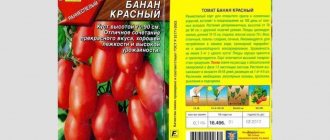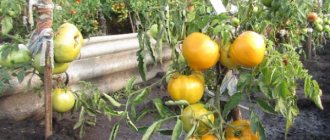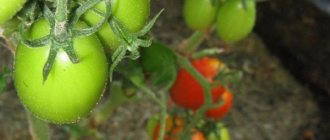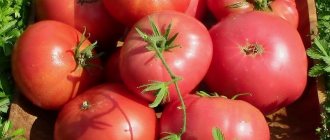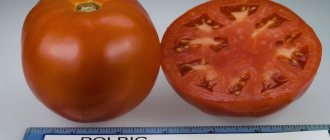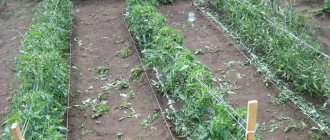Advantages and disadvantages of the variety
The advantages of the variety include:
- high percentage of seed germination;
- good yield;
- high taste indicators;
- long fruiting;
- versatility of use;
- ability to ripen;
- immunity to many diseases.
The main disadvantages of the variety include:
- requirement for sufficient lighting;
- the need for fertilizing and timely application of fertilizers;
- cultivation in open ground is not recommended;
- affected by brown rot.
Harvesting and application
The fruits are harvested on day 110-115 . Used fresh for making salads and sandwiches. Canned - for storing juices, sauces, pastes, snacks and lecho for the winter. They are not used for whole-fruit canning due to the large fruits.
With careful handling, it can be stored for a long time, but does not tolerate transportation well - the skin of fully ripened fruits cracks. To avoid this, the fruit should be removed from the bush before its technical maturity.
Productivity
The Sugar Bison tomato belongs to the category of large-fruited varieties. The growing season from the appearance of the first shoots to the beginning of fruit ripening does not exceed 100 days. If all planting conditions have been met, the first harvest can be harvested at the end of July.
Over the entire season, up to 7 kg of fruit can be collected from one bush. If you follow the proposed planting scheme for 1 sq. m. no more than 2-3 plants, then it is possible to collect up to 20 kg of high-quality tomatoes.
The amount of harvest directly depends on compliance with the rules of planting and care, as well as on timely watering and fertilization. If everything is done correctly, you will be pleased with the harvest. Tomatoes collected in an unripe form can ripen at room temperature without losing their marketability and taste.
Advantages of a greenhouse variety
Before buying seeds, vegetable growers carefully study the varietal characteristics of new species. Tomatoes “Sugar Bison” are able to win attention from the first minutes of acquaintance. The description has all the desired qualities:
- stable yield indicator;
- excellent taste;
- attractive appearance;
- resistance to diseases and weather changes.
To get a closer look at the “Sugar Bison” tomato, we will focus not only on the description and photo, but also on the reviews of those gardeners who planted the variety on their site.
The main characteristics with which it is better to start describing the “Sugar Bison” tomatoes are the ripening period and the type of growth. Why are they important? The ripening period of the fruit will tell you when to expect the harvest, to start sowing seeds, what pests and diseases are active during the growth period of the tomato. The type of growth allows you to determine the nuances of care and advantages of the variety.
“Sugar bison” refers to indeterminate tomato varieties of medium-early ripening. An experienced vegetable grower will immediately note that the bush grows without restrictions, which means it needs supports, garter, shaping, and pinching. But these varieties have more resistance to viruses, pathogenic fungi and many pests. Of course, a big plus. Mid-early tomatoes can be eaten 3.5 months after the seeds sprout. Thus, summer residents are already planning their workload for the summer in advance.
Features of cultivation and care
To get a good harvest of tomatoes, you need to grow healthy and strong seedlings.
Growing seedlings step by step:
- Soaking seeds in a growth stimulator (3-4 days).
- Land preparation. Take garden soil, peat and sand in a ratio of 3:1:1. You can use universal primer, which is sold in the store. It is also very convenient to use peat tablets.
- Plant the seeds in prepared nutrient soil or peat tablets. The depth of planting the seeds is 1.5-2 cm. The distance between the seeds is 2-3 cm. The plantings are watered with warm water, covered with film and placed in a dark and warm place.
- When full shoots appear, the shelter is removed and the containers with seedlings are transferred to a well-lit place. If the weather is cloudy and there is not enough sunlight, the seedlings are illuminated with additional lighting.
- Watering the seedlings is carried out as the top crust of the earth dries.
- Seedlings are watered every 7 days with complex fertilizers for tomatoes.
- When the first two tomato leaves appear, the seedlings are planted in separate containers. If the seeds were sown in peat tablets, replanting will not be necessary, since the seedlings can be planted in the ground along with the tablets.
Planting seedlings in a greenhouse:
- Containers with seedlings are spilled with warm water and left for 30 minutes so that the water is completely absorbed. This will make it easier to transplant the plants without damaging the young roots.
- Prepare the bed for planting. Humus is scattered over the garden bed (10 kg per 1 sq. m) and the entire area is dug up.
- Next, make holes to a depth of about 25 cm. For 1 square. It is recommended to place no more than 2-3 plants.
- The seedlings are carefully removed from the container in which they grew, being careful not to touch the roots, and placed in the hole. If the plants grew in peat tablets, then they are placed in the hole along with the tablet.
- Lenka is covered with earth and pressed lightly.
- All plantings are well watered with warm and settled water.
Further plant care:
- Plants are watered once every 5-7 days, but very abundantly.
- Stepping, forming a bush into 1-2 trunks.
- After 2-3 weeks, the bushes are tied to trellises in the planting field.
- Fertilizing is applied before flowering, during the formation of the ovary and during the period of fruit ripening. It is better to use biological products as fertilizers.
- Weeding, loosening, mulching, daily ventilation of the greenhouse.
- Protection against brown rot is carried out using the drug “Confidor”.
How to grow tomatoes
The seedlings are transplanted into the beds 60-65 days after the first shoots appear. The optimum temperature is +16 °C during the day, +10 °C at night. Transplantation is carried out at the end of May or beginning of June.
Landing
Tomatoes are planted according to the 50*60 pattern (3-4 bushes per 1 m²) . 2 days before transplanting, the seedlings are watered, and the area where the tomatoes are planted is dug up. Cucumbers, zucchini, dill and carrots will be good predecessors for tomatoes, but in the area where tomatoes, potatoes and peppers grew, tomatoes are not planted - the plants are susceptible to the same diseases and suffer from the same harmful insects.
Before planting, the soil is disinfected with boiling water or a solution of potassium permanganate. After 4-5 days, the bushes are tied up for the first time.
More about large-fruited tomatoes:
Tomato “Big Momma” and the secrets of growing large fruits
Tomato Bull's heart, characteristics and description of the variety
Care
Plants are watered with warm, settled water strictly at the root, avoiding moisture getting on the stem and leaves . Sugar bison is not a moisture-loving variety, so it is better to underwater tomatoes than to overwater them.
To prevent the sun's rays from leaving burns on the leaf blades, water the tomatoes in the evening or early in the morning. After watering, the plants are immediately earthed up, weeds are removed from around them and the soil is loosened. As soon as the first ovaries form on the tomatoes, loosening and hilling is reduced to 1-2 times every two weeks.
Depending on the growth phase, tomatoes need different feedings . Nitrogen fertilizers are applied when the bush grows green mass and inflorescences form. Phosphorus-potassium - when the ovary forms on the bushes and the fruits grow. Fertilizing is applied every 12-14 days.
The variety is indeterminate, which means that the bush is not limited in growth . It is pinched when it reaches a height of 1.5-1.8 m, so that the upper fruits have time to ripen before the onset of frost. The plant is formed into one stem. The remaining stems and stepsons are removed.
Important! Stepchildren are removed by hand. When using a knife or blade, there is a risk of transferring an infection or fungus from bush to bush, which is still invisible to the human eye. If using a knife, the blade is disinfected after each plant.
Some gardeners form Sugar bison into two stems . The photo below shows the shaping of an indeterminate tomato.
To prevent tall bushes from bending to the ground and breaking under the weight of green mass and fruits, tomatoes are regularly tied up as they grow.
Features of cultivation and possible difficulties
When growing Sugar Bison tomatoes, a novice gardener may encounter a number of difficulties. The list presents the main ones and ways to solve them :
- When a large amount of greenery forms on the plant, the fruits become smaller and ripen slowly - as the tomato grows, the lower foliage is torn off.
- Tomatoes do not tolerate excess moisture well, but need regular watering - reduce the amount of watering without harming the plants by mulching the soil with peat, dry straw or grass.
- Tomatoes ripen at a lighter weight than the manufacturer claims - remove excess ovaries, leaving up to 3-4 inflorescences on one bunch.
Diseases and pests
Manufacturers do not indicate on the packaging information about the immune system of Sugar Bison tomatoes. But experienced summer residents still carry out preventive measures against common tomato diseases and harmful insects.
In greenhouses, tomatoes develop fungal diseases . To avoid this, gardeners carefully ventilate the shelters, and treat the plants with the following preparations:
- "Fitosporin";
- "Ekosilom";
- "Quadris";
- "Ridomil Gold".
Having discovered brown rot on tomatoes , remove the affected tomatoes and reduce nitrogen fertilizing and watering.
Plantings are attacked by harmful insects such as aphids and thrips. They are fought with the help of the drug “Zubr”. “Prestige” will save you from the Colorado potato beetle, and “Confidor” from the whitefly.
Advice. The smell of nasturtium or marigold repels many harmful insects, so these flowers are planted near tomatoes.
Reviews from gardeners who planted the variety
Sabrina, Kemerovo
I planted Sugar Bison last year. I was pleased with how the seeds sprouted and the harvest pleased me. The fruits are pink, large, sugary at the break and taste very good.
Volzhanka786, Kazan
Be sure to plant Sugar Bison - delicious tomatoes. Last year I raised it for the first time, and I will do it again this year. Those picked red don’t want to lie down at all, after 2-3 days black spots appear on them, if you just pickle them right away, but the skin of my tomatoes burst from the boiling marinade. The marinade is normal, you can eat it.
Barbie
Last year I planted Sugar Bison from Sibsad, everything was excellent - from germination to the fruits themselves, super, I’ll plant them again!
Ellenna
Last year I planted Sugar Bison - very tasty and large tomatoes. There were large ones up to 650 g. The yield was quite decent, 2-3 per cluster, the average fruit weight was 350 g, there were 5 clusters. In general, quite.
Tittan, Sevastopol
Sugar bison is a super-yielding variety of universal use. Height up to 2 m. Fruits are red, flat-round, 200-300 g. The taste is excellent. Stability is relative.
RYZANNA
My Sugar Bison grew up to the ceiling in a greenhouse last year, the harvest was average, but the fruits were tasty, but I wouldn’t call it sugar.
Galina, Stavropol region
The fruits were bright pink, round, smooth, weighing 250-300 g. Sugars of excellent quality. The productivity even in unfavorable years was pleasing. It was possible to collect up to 5-6 kg from one plant.
Diana
I planted the Sugar Bison tomato last year and got a very decent harvest. And the tomatoes were tasty and large. But I would really like to give up store-bought seeds and plant collection varieties.
Selena-tlt
The Sugar Bison bushes have grown powerful and tall. Tomatoes are of excellent presentation, with excellent taste. On average, the fruits weighed 200-300 g, the first ones weighed about 600 g. Used for processing, obtaining juices and pastes. And the fresh salads were delicious with these tomatoes! I recommend it to everyone!
Description
The originator of the variety is the breeders of Moscow Agro . The company appeared on the market in 1989. Over the years, the assortment of the agricultural company has increased to 3,500 types of varietal and hybrid seeds of vegetable and flower crops of its own, domestic and foreign selection.
Testing of the variety began in 2013, and already in 2015 the tomato was included in the State Register of the Russian Federation. Seed producers recommend the variety for cultivation in all regions of the country in open ground and greenhouses.
Distinctive features
Indeterminate mid-early variety. The height of the bush is 150-180 cm , the fruits reach the stage of technical maturity in 110 days. The trunk is sparsely leafy. The leaves are dark green, increased in length, and have short fluff.
The first flowers appear after the seventh leaf rosette, then after every pair of leaves. Five fruits are borne on one cluster.
Fruit characteristics, yield
The fruits are round with a sharp tip, shaped like a heart . When biological maturity is reached on green tomatoes, a dark spot forms at the stalk; at the technical stage it disappears, the fruits acquire a dark pink or crimson hue.
Other qualities of Sugar bison tomatoes:
- fleshy juicy medium-dense pulp;
- the skin is dense, smooth, ribbed;
- number of seed chambers 6-12;
- delicate sweet taste;
- weight – 200-250 g (fruits on the lower branches are larger – 350 g).
Subject to the rules of agricultural technology from 1 sq. m harvest 8-10 kg .
tomato variety Sugar bison
Tomatoes Sugar bison - video
As a rule, only experienced gardeners undertake to grow the Sugar Bison tomato variety. But, if you are ready for hard work and can provide the plants with the necessary conditions for growth and ripening, then you will undoubtedly get a good harvest of tasty and juicy tomatoes.
Sugar bison tomatoes are distinguished by good yield, large fruit, taste and a heart-shaped shape loved by Russian farmers. The fruits are universal in use.
In the article we will give characteristics and descriptions of the variety, as well as recommendations from experienced summer residents on growing tomatoes in greenhouses and open ground.
Types of tomato
Among the variety of varieties of this garden crop, several main ones can be distinguished, namely: pink Bison, orange, yellow and black. Let's take a look at some of these varieties of determinate tomatoes in a little more detail.
Do-it-yourself drip irrigation for your dacha at no cost: do it yourself easily and simply
The Orange Bison variety was bred for the purpose of growing it in greenhouses and open garden beds located in mid-latitudes. Its fruiting begins approximately 3 months after the appearance of the first shoots.
Orange tomato
The Black Bison tomato is also prone to greenhouse living conditions, which guarantees its fruit production even in winter. When examining the appearance of the ripe fruit of this plant, one immediately notices its characteristic color, rich in violet and purple shades.
For this reason, Black Buffalo tomatoes are used not only as a vegetable product for consumption, but also for decorative purposes of the area where they are planted.
Black tomato
Farmer reviews
Reviews about the yield of the Sugar Bison tomato are positive . Gardeners who grew this variety were satisfied with the harvest and will grow it again.
Pavel, Chelyabinsk : “At the dacha I grow several varieties of bison.” I have both Yellow and Black, this year Sugar appeared. I really like all the varieties. The fruits are tasty and beautiful. Plants do not get sick and respond well to fertilizing. The harvest is decent, so there is no need to plant a lot of bushes. This reduces the time required for care. I’m very pleased with my choice.”
Alina, Samara : “For the third year now I have been planting the Sugar Bison tomato variety, I am very pleased with the harvest. Tomatoes are sweet and sugary, that’s why I like them. Their color is crimson-red. To make the seeds swell, I soak them in a weak solution of potassium permanganate before planting. This method can also be used for disinfection. The first shoots already appear on the 6-7th day. We eat tomatoes fresh, and this variety also produces very tasty adjika with horseradish.”
Antonina, Zadonsk : “I’ve been growing it in a greenhouse for three years now. Seed germination is excellent, seedlings grow strong. But in the first year I ran into trouble - late blight attacked. I had to dig up a couple of bushes altogether. Now I always treat all tomatoes with Fitosporin. The tomatoes themselves are beautiful to look at, and the taste is simply fabulous!”
Brief information about the variety
- Fruits and bush : tomatoes are raspberry-pink in color, the average weight varies from 200 to 250 g, some specimens reach 300-350 g. The shape is round. An indeterminate bush (with unlimited growth) reaches 170-190 cm in height.
- Productivity : the first fruits ripen 105-110 days after emergence.
- Resistance : resistant to many nightshade diseases, but susceptible to brown rot. Weak cold resistance.
- Distribution : can be grown in any climatic zone of Russia, because greenhouse culture.
- Application : universal.
- Planting : seedling method. The optimal time for sowing seedlings is late February - early March. Soil: light, loose, slightly acidic, fertilized with organic matter and mineral fertilizers
- Care : fertilizing, watering, loosening, tying, forming a bush of 1-2 stems.
- Fruiting period : the first tomatoes ripen 105-110 days after emergence. Tomatoes can be stored in a cool place for about 2 months.
Transfer
Transplantation of seedlings is carried out after 10 days of hardening. Tomatoes are taken outside in the first half of the day and kept in the fresh air for 2-3 hours. On the last day before planting, the tomatoes are left outside overnight.
():
If seedlings are to be transplanted into a greenhouse, hardening is not necessary, because The conditions in the greenhouse are almost no different from room conditions.
Preparing the bed
The seedlings are transplanted into the greenhouse. To grow this crop, a bed with loose, light soil, fed with complex fertilizers, is suitable. Weeds and plant debris are removed from the garden bed and sprinkled with last year's manure or leaf compost (10 kg).
Additionally, mineral substances are added: 100 g of superphosphate, potassium sulfate and 3 kg of wood ash. After this, they dig up the soil onto the bayonet of a shovel, level it and water it.
2 weeks before planting Sugar Bison tomatoes, the soil is disinfected and its nutritional properties are increased - watered with a urea solution (300 g of substance per 10 liters of water).
Disembarkation scheme
Taking into account that this is a tall crop, 3-5 bushes are planted in a 1 m² bed. The distance between plants is 50 cm, in a row - 60 cm. Near the holes, stakes are installed for further support.
Dig holes according to the size of the root system, then water each with 1 liter of water. After absorbing the moisture, the tomatoes are planted, sprinkled with soil and hilled up.
Landing
Sugar Bison seed sowing begins in late February or early March. To plant, planting equipment and soil are prepared. It is better to choose wooden or plastic boxes as containers for seedlings.
The soil can be prepared in the fall from your own plot or purchased at the store. To increase seed germination, the soil must be rich in nutrients, loose, with a pH level of 6.2 to 6.8.
Having prepared everything necessary, the seeds are treated with a disinfecting solution and tested for germination. After this, landing is carried out in the following order:
- Furrows 1.5 cm deep are made in the soil located in the boxes.
- Tomato seeds are placed in them and poured on top.
- The box is watered using the drip method with warm water.
At the end of the planting work, the boxes are covered with polyethylene film and put away in a warm, dark place. After 5–6 days, when the sprouts begin to hatch, the boxes are moved to a well-lit place, having first removed the film from them.
When the first 2-3 leaves are formed on the plant, it is picked. The transplant is carried out in a new spacious place, with a lump of earth, without damaging the root system.
After 55–60 days, when the vegetable crop is completely strong, it is planted in a permanent place of growth.
Errors during cultivation
If some rules of agricultural technology are violated, gardeners grow weak seedlings, the bushes develop slowly, bloom and bear fruit sparingly. There are several reasons for this:
- use of low-quality seeds (infected with diseases or expired);
- planting in too small a container using poor, heavy or acidified soil;
- violation of picking rules - planting tomatoes at a late stage of growth, transplanting without prior watering, which often leads to injury to the root system;
- lack of hardening, due to which the seedlings, after transplanting to the garden bed, turn yellow, wither and die from the sun or cold;
- violation of the watering regime, fertilizer application schedule and lack of regular weeding and loosening;
- non-compliance with crop rotation rules - annual planting of tomatoes in the same place is unacceptable, because there is a high risk of contracting the same infections (this crop can be returned to its original place only after 3 years);
- the lack of preventive treatments can also negatively affect the health of the bushes and their productivity.
Tomato "Sugar Bison" description
Sugar bison, Monomakh's hat, Caramel
tomato variety Sugar bison
Diseases and pests
It should be noted that the immunity of this variety is average, and therefore resistance to the main diseases characteristic of this vegetable crop is not too high. The main disadvantage of the Sugar Bizo variety is its low resistance to brown rot, which often has to be combated.
Photo of brown rot on a tomato
It is also necessary to follow the rules for caring for these vegetable plants in greenhouse conditions, frequently ventilate greenhouses and hothouses, avoid increasing soil and air humidity, and also carry out preventive treatments of bushes and soil with appropriate fungicides.
TOMATOES!
Tomato Raspberry flame F1 Tomato BATYANYA
Bush care
Agricultural technology for growing “Sugar bison” includes the following activities:
- Formation. To ensure that the dimensions of the grown tomatoes correspond to the nominal value, the bushes are planted into 2 stems. Formation begins on the 10th day after planting, when final rooting occurs;
- Tie the bush to the support. This is done to prevent the stem from being broken by a heavy fruit brush or a gust of wind;
- Balanced watering. The variety tolerates drought, but has an extremely negative attitude towards excess moisture in the garden. The gardener must find an individual watering rate for a specific soil;
- Loosening the soil and weeding between waterings;
- Root feeding with alternating organic and mineral fertilizers. Held once every 2 weeks.
